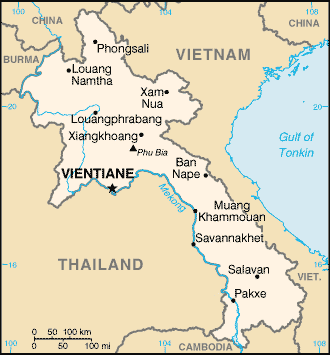Laos
Laos or the Lao People's Democratic Republic is a landlocked south east Asian country, bordered by Cambodia, Vietnam, Burma, China and Thailand.
Government
The Communist Pathet Lao assumed control of the country in 1975 and followed a close diplomatic relationship with bordering Vietnam. Laos has gradually liberalised its economy since 1986.
On August 14, 1991, the Supreme People's Assembly adopted a formal constitution. Although the Assembly had been tasked with creating a constitution in 1975, the issue was considered low priority by the government. International organisations were reluctant to operate in Laos without a fixed national law. Even the Communist Party's newspaper, Xieng Pasason (Voice of the People) commented on the lack of a constitution; having no laws is... a source of injustice and violation, thus leading to a breakdown of social order and peace, the breeding of anarchy, and the lack of democracy. [1] In June 1990, demonstrations were held demanding a multi-party system, but the government threatened arrestment if the demonstrations did not cease. Earlier, in April, a group of intellectuals and political representatives began criticising the countries one party system. One member of the so called 'Social Democratic group' was a Minister of Science and Technology who resigned over the issue.
Criticism of the draft continued, with demonstrations by students in many European cities. With agitation at home and abroad, it looked like the Lao communist party would crumble in much the same way the Iron Curtain had begun to crumble in Europe. The government cracked down at these demonstrators in October, leading to many arrests. The constitution guaranteed freedom of speech and public expression, but the lack of willingness of the ruling elite to countenance democratic change undermined the new constitution from the offset.
The President of the country is elected to a five year term by three fifths of the National Assembly. The Prime Minister is the head of government and appointed by the President for a five year term.
Geography & Natural History
Laos is a landlocked country which is covered mostly by rugged mountains, though there are some Plains and Plateau's. Phou Bia is the largest mountain, standing at 2,817 metres. [2]
Economy
The Communist government of Laos began the process of economic Liberalisation in 1986. The results displayed sharp economic growth; GDP increases averaged around 6% every year between 1986-2006, except a short blip caused by the Asian Financial Crisis in 1997. Despite high growth, the infrastructure in underdeveloped. There is no national rail system and roads are primitive at best. Electricity is largely confined to larger population centers. Subsistence Agriculture accounts for around half of GDP and 80% of employment. In late 2004 Laos gained normal trade status with the USA, allowing Laos exporters to benefit from lower trading tariffs.
China and Vietnam are trading partners with Laos, but Thailand is particularly important to the future growth of the Laos economy.
Demography
As of an estimate by the United State's Central Intelligence Agency in July 2007, Laos has a population of around six and a half million persons; her ethnic groups comprise the following; Lao Loum (lowland) 68%, Lao Theung (upland) 22%, Lao Soung (highland) including the Hmong and the Yao 9%, ethnic Vietnamese/Chinese 1%. [3]
Lao's religious groups comprise the following; Buddhist 65%, animist 32.9%, Christian 1.3%, other and unspecified 0.8% (1995 census)
History
See Laos, History
References
- ↑ http://countrystudies.us/laos/86.htm
- ↑ See CIA World Factbook; https://www.cia.gov/library/publications/the-world-factbook/geos/la.html
- ↑ Ibid
